Auto-Clustering
Database clusterization is an obligatory requirement for highly loaded production applications to ensure data availability and high performance. However, the configuration of a reliable cluster is not a trivial task even for experienced developers and system administrators. For solving this problem, the platform introduced out-of-the-box clustering for MariaDB/MySQL/Percona to make applications highly available by default.
The implemented solution provides a set of benefits:
- high availability with pre-configured replication options - Primary-Secondary, Primary-Primary, Galera, XtraDB
- scalability and autodiscovery – new nodes, added during horizontal scaling, are connected to the cluster with all required adjustments being applied automatically
- efficient load balancing – each cluster is supplemented with two ProxySQL nodes for load balancing with automatic splitting of read/write requests
- automated failover – the database nodes that are temporarily unavailable or have high latency are automatically excluded from the cluster and re-added once the connection is restored
All these benefits can be achieved just in a few clicks within a topology wizard. Explore the steps below to activate auto-clustering for your MariaDB/MySQL/Percona databases in PaaS.
Enable Automatic Clustering for Databases
Click on New Environment at the dashboard and choose MariaDB/MySQL/Percona database.
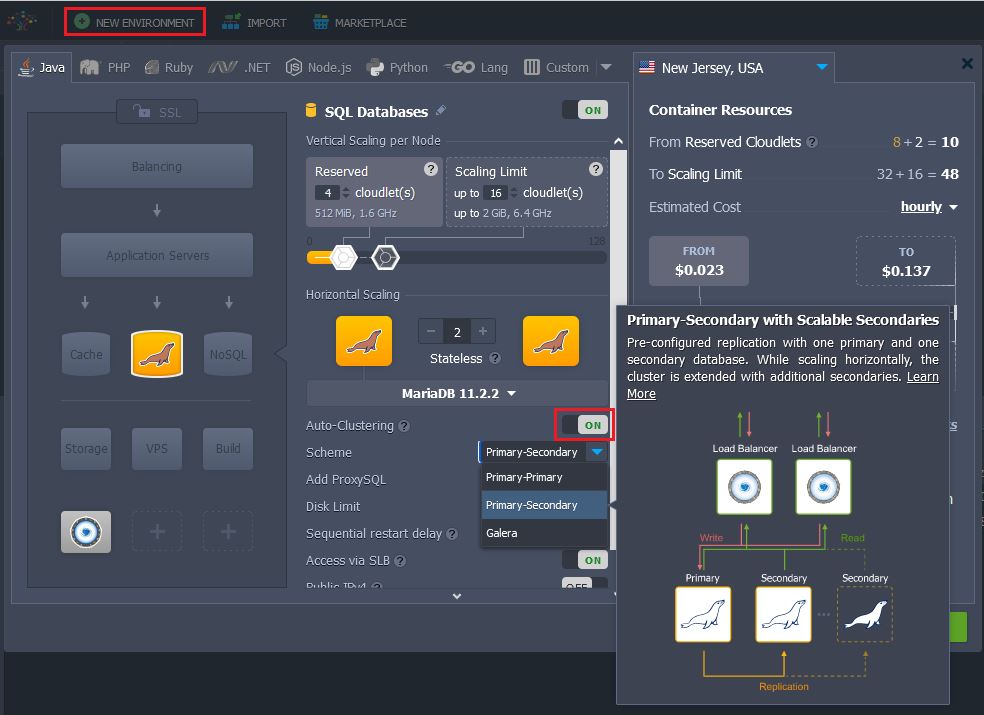
Activate the Auto-Clustering button. As a result, a dropdown with different replication schemes will appear:
- MariaDB - Primary-Secondary, Primary-Primary, and Galera
- MySQL - Primary-Secondary and Primary-Primary
- Percona - Primary-Secondary, Primary-Primary, and XtraDB
Auto-Clustering Options
Choose the replication type you prefer, add the necessary number of nodes.
Highly Available ProxySQL Load Balancer
Each MariaDB/MySQL/Percona auto-clustering solution has two ProxySQL nodes enabled by default in front of the database cluster. If required you can exclude them from the cluster topology before installation with the respective switch. Keep in mind that you won’t be able to do that afterward.
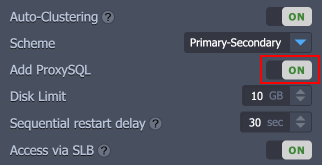
Database Cluster Access Credentials
During cluster creation, the platform automatically generates database access credentials, but you may override them with your own ones in three simple steps:
- Click on the Variables button.
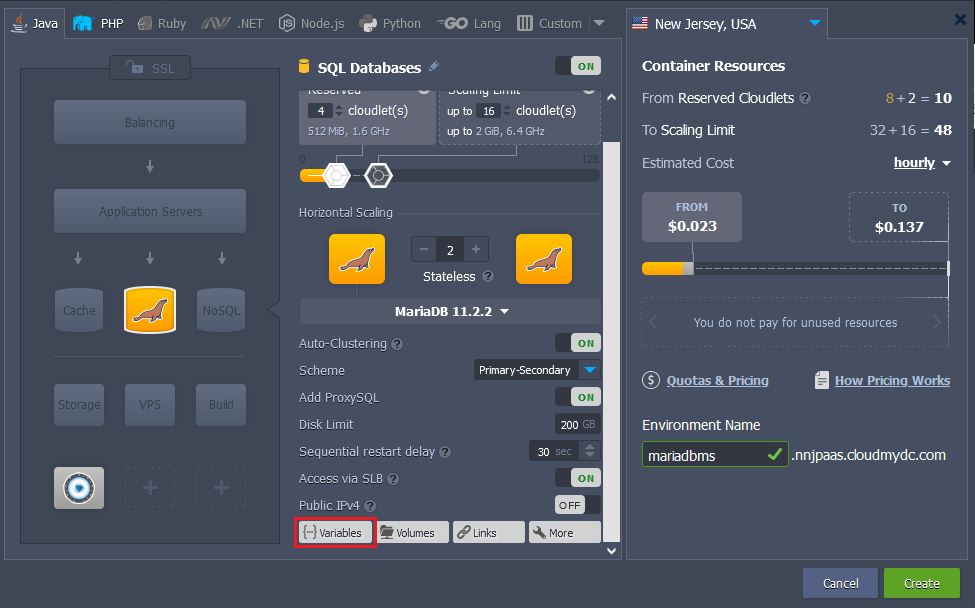
- Then press Add to provide custom user’s database credentials via two variables DB_USER and DB_PASS as follows:
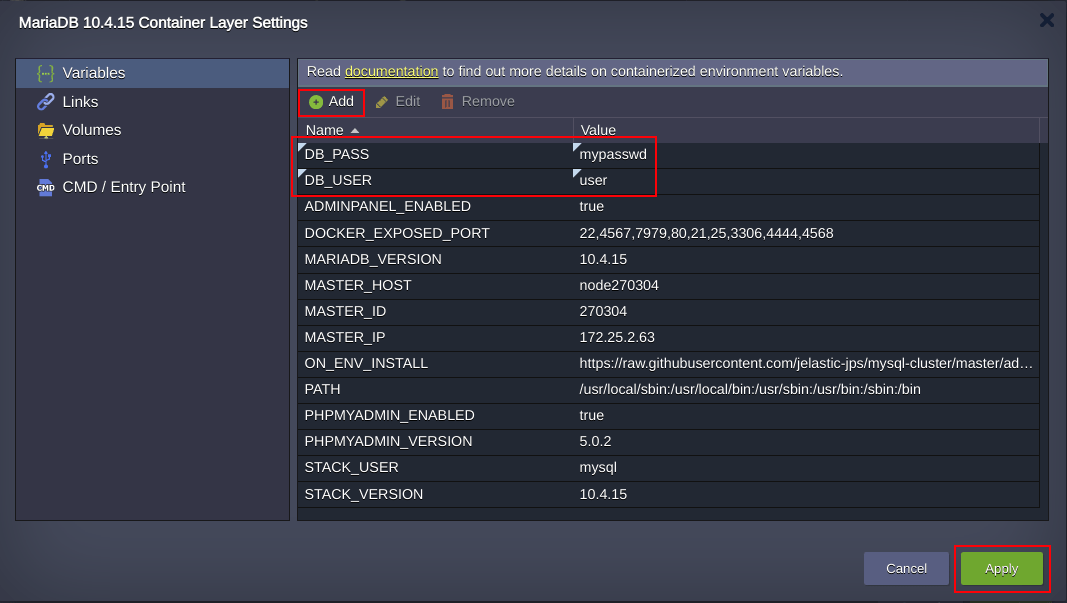
- Press Apply and custom credentials will be mailed to you upon cluster successful installation as for access to the PHP MyAdmin at Primary Node and database cluster Entry Point.
Cluster Horizontal Scaling
If you decide to scale the primary-secondary/primary-primary topologies with an extra database node, it will be created via cloning an existing secondary node. Once the cloning procedure is completed the database on the new cluster member catches up data via binlog replay. Such an algorithm guarantees the binlog will never expire and horizontal scaling takes a short period of time.
Cluster Layers Isolation
Depending on whether you are going to use an external application or not, you may decide what layers you will expose outside - all or the entry point proxy layer only. Turn the SLB access switch into the required position for each layer and click Create.
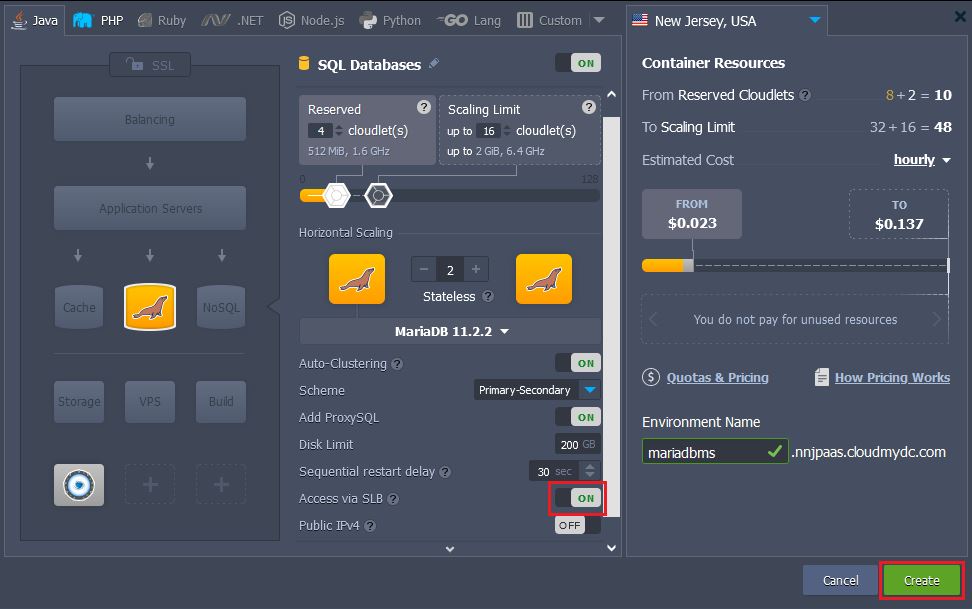
That’s all! No configurations required, the cluster is ready to work with.

Database Cluster Access Information
After successful installation, you’ll receive a number of emails with the cluster information:
- PHP MyAdmin at Primary Node - web administration interface with credentials to access the database server for interactive management.
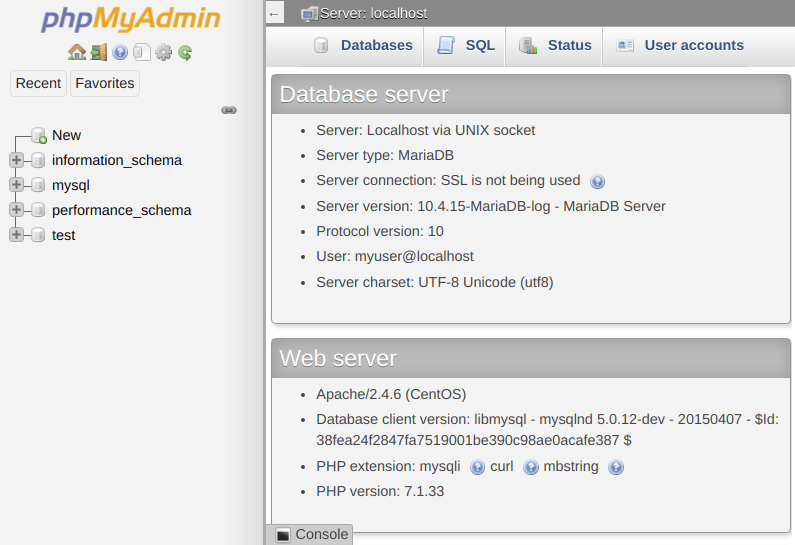
- Entry Point for Connections to Database Cluster - hostname and credentials for connecting an application to the database cluster.These nodes form a proxy layer referred to as the entry point for the database cluster with hostname as follows:
proxy.${envName}.${platformDomain}.

In case you are going to create and use the custom user accounts after cluster installation, you should add them to the mysql_users table on each ProxySQL node, otherwise you won’t be able to establish connection to the database via the proxy layer. To do this issue commands below:
$ MYSQL_PWD=admin mysql -h 127.0.0.1 -P6032 -uadmin -e "INSERT INTO mysql_users (username,password,default_hostgroup) VALUES ('<username>', '<password>', 2);"
$ MYSQL_PWD=admin mysql -h 127.0.0.1 -P6032 -uadmin -e "LOAD MYSQL USERS TO RUNTIME; SAVE MYSQL USERS TO DISK;"
Substitute and with credentials of a newly created database account.
- Cluster Orchestrator Panel - credentials to access the Orchestrator panel, intended for convenient cluster management. Use the received credentials to access admin panel of cluster Orchestrator installed on ProxySQL node, that provides a possibility to review the cluster topology information: slick visualization of topologies, replication problems if there are any, read/write distribution, state of health check-ups and autodiscovery of newly added DB nodes, etc.
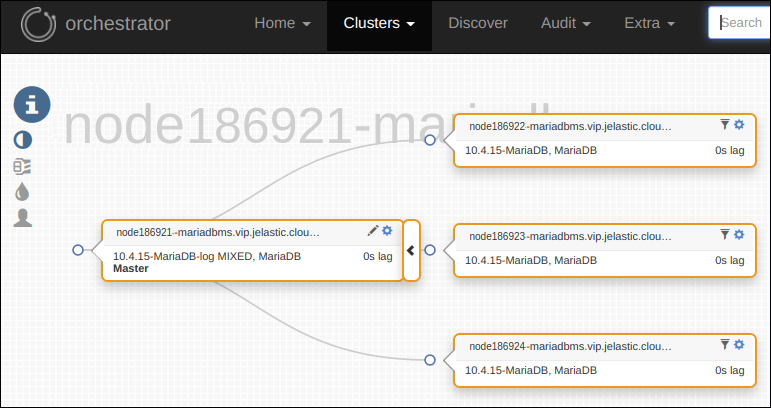
What Replication Type to Choose?
Let’s consider the details about each replication scheme available for databases within the platform in order to understand which one is the most suitable for the specific needs and use cases.
Primary-Secondary MariaDB/MySQL/Percona Replication
Primary-secondary replication is the most common used topology, that provides a good consistency (i.e. exactly one node to modify data), but no automatic failover upon primary failure. A write latency in asynchronous replication is low because the write is recorded locally by the primary server before writing to the secondary servers. It allows to scale-out the reads, providing the highest performance, since adding more replicas does not affect replication latency. Secondaries can be read without impact on the primary, providing such obvious advantages as:
- High performance for read requests
- Database backup can be done with no impact on primary instance
- Analytical requests can load the secondary instance only (without affecting the primaty)
Primary-Primary MariaDB/MySQL/Percona Replication
Primary-primary asynchronous replication operates with two primary nodes simultaneously, Compared to the default primary-secondary solution, it benefits on the balancing of writing load and simpler recovery upon one primary node failure.
In contrast to the default settings, in primary-primary cluster scaling leads to secondaries addition to the cluster. Upon creation, the secondary instances are equally distributed between primary nodes that allow smoothly distribute the replication workload and increase the reads capacity of the cluster.
MariaDB Galera and Percona XtraDB Clusters
Galera and XtraDB clusters topologies are multi-primary synchronous replications that are performed at a transaction commit time, by broadcasting transaction write set to all cluster nodes for applying. They make sure the write is sent to all nodes in the cluster before this write will be actually committed.
A user application can send reads and writes to any node in the cluster, that provides an ability to scale-out read and write transactions. Adding nodes to a cluster is fully automated. Excluding nodes from the cluster is just a matter of removing the unneeded or failed ones. There is no need anymore to implement the bulky logic for separation of reads and writes, the scaling potential can be immediately implemented with no need to change the application logic. Galera and XtraDB offer one of the best protection against data loss and inconsistent databases since there is no delay in replicating data. If one of the cluster nodes fails the user application won’t see it and will continue to serve users using the other nodes that may also be located in other data centers.



